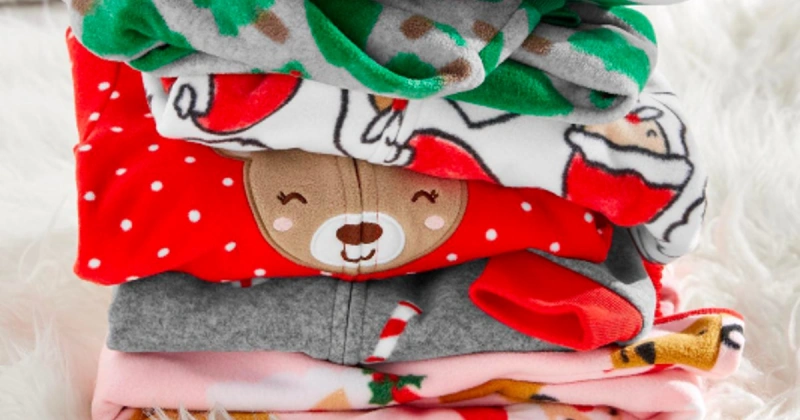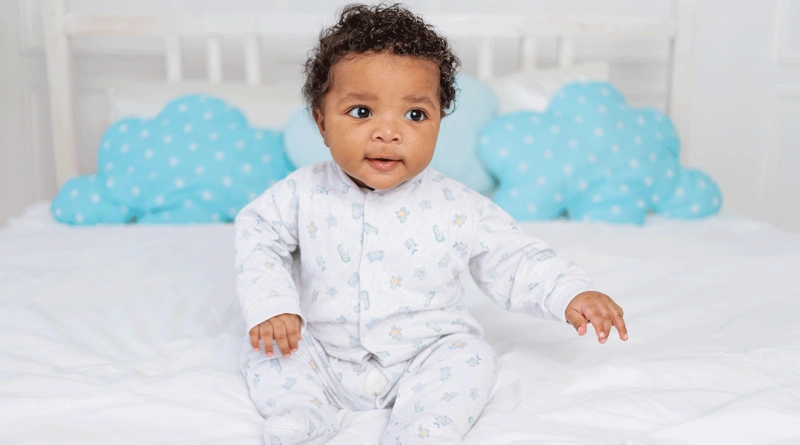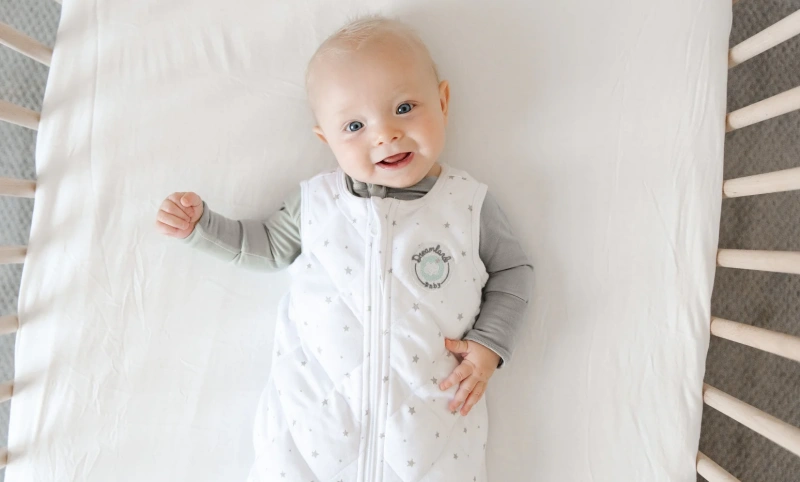When it comes to dressing your baby for sleep, comfort and safety are top priorities. You might be wondering, “Are fleece pajamas safe for babies?” In this ultimate guide for 2025, we’ll take a closer look at fleece pajamas, examining both the benefits and potential risks. While fleece is soft and warm, it’s important to make an informed decision to ensure your baby’s safety.
This guide will walk you through essential points to consider, such as the breathability of fleece, the right fit, and fabric safety standards. We’ll also share expert tips for choosing the best sleepwear for your baby. By the end, you’ll know exactly what to look for when selecting fleece pajamas and whether they are a good option for your little one.
What are Fleece Pajamas?

Fleece pajamas are made from a soft, synthetic fabric designed to trap warmth while remaining lightweight. Originally created as a wool alternative, fleece provides comfort without the itchiness. The two most common types of fleece used for baby pajamas are polyester fleece and microfleece.
Polyester fleece is durable and cozy, while microfleece is thinner, breathable, and perfect for cooler nights, ensuring your baby stays comfortable.
Can Babies Wear Fleece Pajamas?
Babies can wear fleece pajamas, but you should be cautious. Fleece keeps your baby warm, which can be great in cooler weather. However, it doesn’t breathe as well as other fabrics, so if the room temperature isn’t very low, it might cause your baby to overheat. For milder temperatures, choose natural fabrics like cotton that allow air circulation and keep your baby comfortable throughout the night.
Is It Safe for Babies to Wear Fleece Pajamas?

When choosing pajamas for your baby, you want to ensure that the fabric is not only comfortable but also safe. Fleece pajamas can be a great option, but it’s essential to consider the type of fleece. Here’s a breakdown of the different types of fleece fabric and their safety for babies:
Microfleece
Microfleece is a lightweight, ultra-soft fabric made from polyester. It’s thinner than traditional fleece and features a fine texture. It’s breathable, dries quickly, and provides warmth without causing overheating. Microfleece is gentle on the skin, making it a great choice for babies with sensitive skin. Just ensure that the fabric is free from harsh chemicals or dyes to maintain safety.
Polarfleece
Polarfleece is a thicker, highly insulating fabric often used in jackets and blankets. It’s cozy, soft, and excellent for colder weather. The moisture-wicking properties of polarfleece help keep your baby dry, making it a good choice for winter months. However, ensure that the fabric isn’t too thick for your baby, as it may cause overheating. Look for fleece that is free from harmful flame retardants for added safety.
Organic Fleece
Organic fleece is made from natural fibers like cotton, wool, or bamboo. It’s an eco-friendly alternative to synthetic fleece and tends to be softer. Organic fleece is breathable, moisture-wicking, and hypoallergenic, making it suitable for babies with sensitive skin or allergies. Ensure that the organic fleece is certified (GOTS) to meet high safety and environmental standards, making it safe for your baby.
Bamboo Fleece
Bamboo fleece is made from bamboo fibers and is naturally antibacterial and breathable. It’s hypoallergenic and provides excellent moisture-wicking properties, keeping your baby dry and comfortable.
Bamboo fleece also helps regulate temperature, making it ideal for babies who tend to overheat easily. This fabric is free from harmful chemicals, so it’s a safe and natural option for babies with sensitive skin.
Fleece-lined Cotton
Fleece-lined cotton is a combination of cotton on the outside and a soft fleece lining on the inside. This fabric is breathable and less likely to cause overheating compared to 100% fleece. The cotton outer layer is gentle on the skin, while the fleece lining provides warmth without bulk. Since cotton is a natural fabric, it’s safe for babies, and the fleece lining should be free from toxic chemicals to ensure safety.
Sherpa Fleece
Sherpa fleece is a plush, thick fabric often used for outerwear and blankets. It provides exceptional warmth and softness, but it can be too thick for babies, which may lead to overheating. If you choose sherpa fleece for your baby’s pajamas, make sure it’s appropriately sized and not too heavy. Look for sherpa fleece that’s free from harsh chemicals and flame retardants for added safety.
Fleece Made from Recycled Materials
Fleece made from recycled polyester offers an eco-friendly alternative to traditional fleece. It retains the same warmth, breathability, and softness but with the added benefit of sustainability. Recycled fleece can be a safe and eco-conscious choice for baby pajamas. However, always ensure that it is free from harmful dyes or chemicals, as some recycled fabrics may still contain unwanted substances.
Key Factors for Baby Safety
When choosing baby pajamas, safety is the most important factor. Here are key factors to keep in mind for selecting safe and comfortable fleece pajamas for your little one:
Chemical-Free: Always choose fleece fabrics that are free from harmful chemicals, such as flame retardants, dyes, and heavy metals. Organic and certified fabrics are often safer, ensuring your baby is not exposed to toxic substances during sleep.
Breathability: Make sure the fleece fabric is breathable. Breathable fabrics allow air to circulate, preventing overheating, which is crucial for your baby’s safety. Overheating is a known risk factor for Sudden Infant Death Syndrome (SIDS), so always choose pajamas that help regulate your baby’s body temperature.
Softness: Babies have delicate, sensitive skin. Choose fleece that is ultra-soft to the touch. Fabrics that are rough or irritating can cause discomfort or skin rashes. Soft fleece will keep your baby cozy without any risk of chafing or irritation.
Moisture-Wicking: Choose fabrics with moisture-wicking properties to keep your baby dry and comfortable. When babies sweat, damp clothes can lead to discomfort, rashes, or even fungal infections. Moisture-wicking fleece draws moisture away from the skin, maintaining a dry environment for your baby.
Fit: Always ensure the pajamas fit properly. Pajamas that are too tight can restrict movement and cause discomfort, while pajamas that are too loose can pose strangulation or choking hazards. Look for a snug, but comfortable fit to keep your baby safe throughout the night.
Easy-to-Use Closures: Opt for pajamas with simple, secure closures like zippers or snap buttons that are easy for you to open and close but not a hazard for your baby. Avoid small buttons that could pose a choking risk. Always ensure that the closures are smooth and well-secured.
Fabric Feel :Polyester vs Cotton Fleece
Polyester Fleece:
Polyester fleece is soft and fuzzy on both sides, giving it a cozy feel. However, it tends to trap moisture, which can make your baby uncomfortable when they start to sweat. The fabric may become clammy and leave your baby feeling wet. While it dries quickly, polyester fleece can also cause static shocks, which might be uncomfortable.
Cotton Fleece:
Cotton fleece is soft on the inside and smooth on the outside, creating a breathable and comfortable fabric. It provides warmth without trapping moisture, making it a better option for babies prone to sweating. Though it takes longer to dry than polyester, cotton fleece won’t cause static shocks, making it gentler on your baby’s skin.
Are Fleece Pajamas Too Hot for Baby?

Fleece pajamas are warm and cozy, but they can sometimes cause your baby to overheat. Here’s how to ensure your baby stays comfortable and safe while wearing fleece:
Use Fleece Wisely: Fleece pajamas are ideal for colder weather or during nighttime when temperatures drop. However, for daytime naps or warmer seasons, choose lighter fabrics like cotton to keep your baby cool. Fleece is perfect for chillier nights, but other fabrics work better in warmer conditions to avoid overheating.
Room Temperature Matters: Fleece pajamas work best in cooler environments. If your baby’s room is warm, fleece may trap too much heat, causing discomfort. In warmer rooms, opt for breathable fabrics like cotton to avoid overheating and keep your baby comfortable throughout the night.
Fleece Fabric Thickness: Thicker fleece can trap excess heat, which leads to sweating and discomfort. For better temperature regulation, choose lighter fleece or microfleece. These options provide warmth without the risk of overheating, making them a safer choice for babies.
Overheating Risk: Babies are more vulnerable to overheating, which increases the risk of Sudden Infant Death Syndrome (SIDS). Always make sure your baby’s room is at a comfortable temperature. If your baby seems too warm, adjust their layers accordingly to prevent overheating.
Monitor Baby’s Comfort: Always check your baby’s body temperature to ensure they’re not too hot. If they feel warm or are sweating, their fleece pajamas may be too much for the current environment. Adjust the layers and clothing as needed to ensure they stay at a comfortable temperature.
Can Fleece Pajamas Trigger an Allergic Reaction in My Baby?
Fleece pajamas are cozy, but they may trigger allergic reactions or irritation in some babies. Here’s what you should know to help keep your baby comfortable:
Synthetic Fibers Sensitivity:
Fleece made from polyester or other synthetic fibers can irritate sensitive skin. Babies with delicate skin might develop rashes, itching, or redness. If your baby shows signs of discomfort, try switching to a softer, natural fabric like cotton or bamboo for pajamas to minimize the risk of irritation.
Chemical Treatments:
Some fleece fabrics undergo chemical treatments like flame retardants or dyes, which can irritate your baby’s skin. If you’re concerned about chemicals, look for fleece that’s certified organic or free from harsh additives. This will reduce the chances of allergic reactions and ensure your baby sleeps comfortably.
Fabric Softener Residue:
The residue left by fabric softeners and harsh detergents can also cause allergic reactions. Always wash your baby’s fleece pajamas with gentle, baby-safe detergent. Avoid using fabric softeners, which may leave chemicals on the fabric that can irritate the skin and trigger rashes or itching.
Breathing Issues:
Fleece’s texture and tight weave can trap dust, allergens, and moisture, which may trigger respiratory problems, especially in babies with asthma or other respiratory allergies. If your baby has such conditions, monitor how they react to fleece and consider other breathable fabrics to ensure they’re comfortable and safe.
Natural Fleece Alternatives:
For babies with sensitive skin, opting for natural fleece alternatives made from cotton, bamboo, or wool can help reduce allergic reactions. These fabrics are naturally softer and gentler, making them less likely to cause skin irritation. Always choose organic options for the safest, most hypoallergenic experience.
Choose Friendtex Safety Baby Pajamas
Friendtex offers several options that focus on natural and safe fabrics. Here are some popular fabric choices that meet safety standards while keeping your baby cozy:
Bamboo Baby Pajamas: Bamboo fabric is soft, hypoallergenic, and naturally breathable. It’s a great option for babies with sensitive skin. Bamboo pajamas regulate temperature well, keeping your baby cool in summer and warm in winter. Look for Friendtex bamboo pajamas to provide comfort without the risk of irritation.
Muslin Baby Pajamas: Muslin is a lightweight, breathable fabric that’s gentle on your baby’s skin. It has natural moisture-wicking properties, helping keep your baby dry and comfortable throughout the night. Muslin pajamas are perfect for warmer climates, providing just the right balance of breathability and warmth without causing overheating.
Organic Cotton Baby Pajamas: Organic cotton is grown without harmful pesticides or chemicals, making it an ideal fabric for babies with delicate skin. Friendtex organic cotton pajamas are soft, breathable, and safe. This natural fabric is perfect for preventing irritation while ensuring your baby stays cozy all night long.
Linen Baby Pajamas: Linen is made from natural flax fibers and is known for its cool, breathable properties. Linen pajamas from Friendtex keep your baby comfortable in warmer temperatures. The fabric is naturally hypoallergenic and helps prevent overheating, ensuring your baby sleeps soundly without feeling too hot.
Hemp Baby Pajamas: Hemp is a strong, durable fabric that becomes softer with each wash. Hemp pajamas are naturally resistant to mold and bacteria, making them a safe and clean choice for babies. This eco-friendly fabric is breathable, moisture-wicking, and ideal for babies prone to skin irritation.
Conclusion
In conclusion, fleece pajamas can be a safe and cozy choice for your baby, as long as you choose the right fabric, ensure proper fit, and monitor the temperature. Always opt for fleece made from natural or organic fibers when possible, as these are gentler on sensitive skin.
Make sure the room temperature is comfortable and avoid overdressing to prevent overheating. By keeping these factors in mind, you can provide your baby with the warmth and comfort they need for a peaceful night’s sleep.
If you’re looking for high-quality fleece pajamas for your little one, consider quoting from Friendtex. We offer a variety of soft, safe, and breathable options designed to keep your baby cozy and comfortable.


